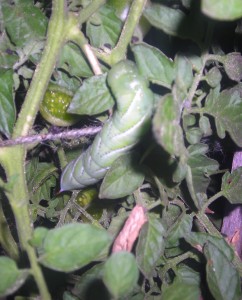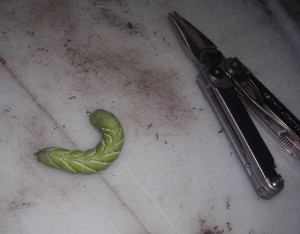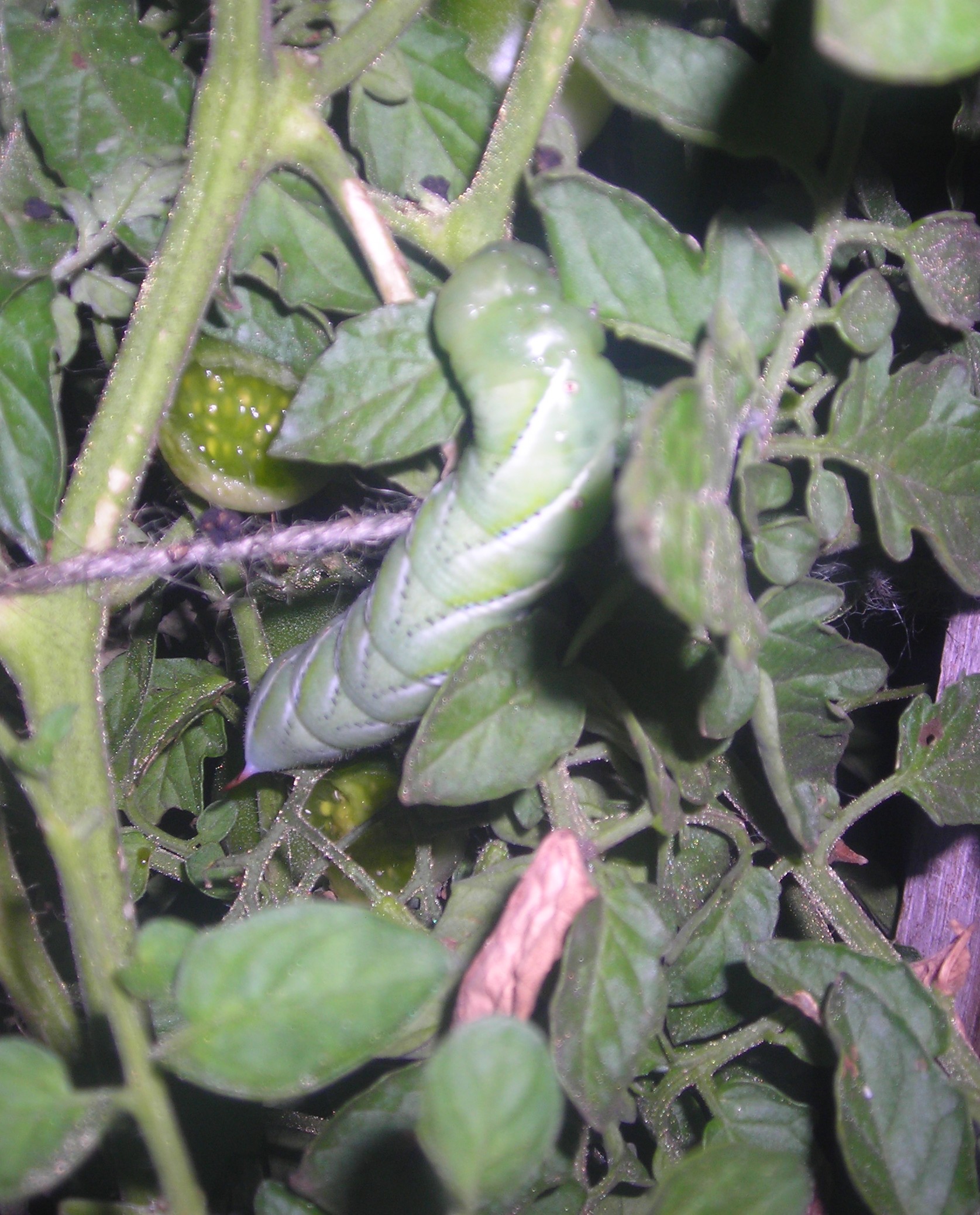On my rounds tonight, I found the tops of one of my cherry tomato plants was devoid of all  leaves. My first thought was that the chickens or ducks cleaned were responsible, then I realized the damage was only at the top, 4 feet off the ground, and behind a fence. I quickly realized I had a bug problem of some sort….and after searching fora couple of minutes, I came across this monster of a caterpillar.
leaves. My first thought was that the chickens or ducks cleaned were responsible, then I realized the damage was only at the top, 4 feet off the ground, and behind a fence. I quickly realized I had a bug problem of some sort….and after searching fora couple of minutes, I came across this monster of a caterpillar.
My initial thought was “Tomato worm!”, and it wasn’t until I sat down to write this entry and do some background research that I realized that I’d fallen for one of the classic blunders,
The caterpillar, often referred to as the tomato hornworm, can be a major pest in gardens. Tomato hornworms are closely related to (and sometimes confused with) the tobacco hornworm (Manduca sexta). This confusion arises because caterpillars of both species feed on the foliage of various plants from the family Solanaceae, so either species can be found on tobacco or tomato leaves, and the plant on which the caterpillar is found does not indicate its species. The larvae of these species can be distinguished by their lateral markings: tomato hornworms have eight V-shaped markings while tobacco hornworms have seven diagonal lines.[2] Furthermore, the caterpillars can be distinguished from the larval stage onwards by the color of the horns on their back ends: M. quinquemaculata caterpillars have black horns, while M. sexta caterpillars have red horns.
Since I distinctly saw a red horn before I threw it into the chickens coop, I found Manduca sexta, or the tobacco hornworm, caterpillar to the Carolina sphinx moth. (For the lawyers worried about it, the tomato hornworm becomes a hawk moth.)
I returned to make sure there weren’t more, and found another. And as I write this I’m itching to go out and check again.
OK, all clear. (Yes, it’s 11 PM and I just re-checked)
Back to the details.
Eggs are laid mostly on the underside of leaves, though sometimes on the top, and hatch out in 2-4 days. This means gardeners have to be vigilant in order to not have to spray! I’m OK with that. How you handle it is up to your acceptable levels of return vs input. As I’ve said before, no sprays here, unless I can safely drink it.
If hornworms are found with white cocoons attached to it, DO NOT KILL THIS TOMATO WORM! The white sacks are the pupae of the Braconid Wasp. These wasps are parasitic insects that prey on hornworms. These wasps hunt down hornworms, inject their eggs into their prey where the eggs hatch into larvae and begin eating the internal organs of the hornworm. After these larvae have matured they bore through the skin of the hornworm and proceed to spin a cocoon and attach themselves to the worm. From the cocoons emerge adult Braconid Wasp which will then hunt for other Tomato Hornworms and Tobacco Hornworms to continue the cycle.
See? Mother Nature IS on our side sometimes!
To recap, check your plants regularly, at least every two or three days. This is a good habit for ALL food production.) Remove any caterpillar that does NOT have white capsules stuck to its back. Wash, rinse, repeat!
I wonder how they taste fried…..

Ha ha! You fool! You fell victim to one of the classic blunders – The most famous of which is “never get involved in a land war in Asia” – but only slightly less well-known is this: “Never go against a Sicilian when death is on the line”! Ha ha ha ha ha ha ha! Ha ha ha ha ha ha ha! Ha ha ha…
Did you click the link?
Probably my favorite movie. Ever.
I’d be careful trying to eat these.their diet may contain toxic plants.if really feel the need to try them put them on a lettuce diet for a few days first.
I’d have to be mighty hungry to eat those…
Sand fleas, on the other hand, are more plentiful, and proven to be tasty